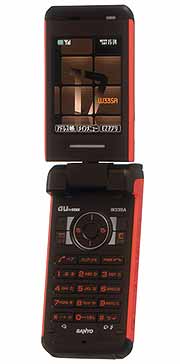We have witnessed our cellphones incorporate an increasing number of functions, everything from from cameras to music players to electronic payment functions. Now we are about to get what we truly want for our phones -- TV. One Seg, a type of TV broadcasting for cellphones, has been attracting a great deal of attention.
At present, there are several types of television broadcasting -- terrestrial analog broadcasting, which is the most widespread, terrestrial digital broadcasting, which has grown in popularity with the spread of flat-screen TVs, and BS and CS broadcasting, both of which transmit signals via satellite.
|
(Pictured here is the "au W33SA," the first One Seg compatible handset, released in December 2005. Until formal service begins, users will be able to watch One Seg trial broadcasting and analog TV broadcasts.) |
In the future, terrestrial digital broadcasting is expected to become the mainstream. In terrestrial digital broadcasting, the frequency assigned to each channel is divided into 13 segments (bands) before it is broadcast. Of these 13 segments, 12 are actually used for broadcasting to households, and the remaining segment is used as a TV broadcast for mobile terminals. This explains the origin of the name "one-segment broadcasting," which has been abbreviated to "One Seg."
So, what is the difference between One Seg and conventional terrestrial analog broadcasting? We have seen a number of cellphones equipped with TV tuners in the past, all of them compatible with terrestrial analog broadcasting. However, the programs on these devices suffer from choppy picture quality. Reception also often becomes unstable when moving, and noise and static accompany most TV viewing. In contrast, One Seg is based on terrestrial digital broadcasting, and it is designed with the assumption that viewers will be on the move.
The inclusion of error correction technology ensures that users will be able to enjoy stable picture quality, even when moving from place to place.
Another difference relates to power consumption. Cellphones equipped with terrestrial analog TV tuners consume a lot of power, limiting continuous TV viewing to between 30 and 60 minutes. While watching TV, batteries become depleted, cutting off the ability to send/receive telephone calls and mail. However, One Seg broadcast tuners feature low power consumption, enabling several hours of continuous TV viewing on the cellphone. Sporting events can be watched in their entirety (provided there are no extra innings or overtime). One Seg also has the advantage of allowing access to other cellphone content linked to broadcasts.
One Seg programs will generally consist of content identical to terrestrial digital programs, but the possibility of offering programs unique to One Seg in the future is now being studied. The area of One Seg reception will coincide with the area covered by terrestrial digital broadcasting. However, the conditions in some areas (inside some buildings, underground, etc.) may limit reception.
The formal launch of One Seg service is now scheduled for April 1 of 2006. In December 2005, "au" released the first One Seg compatible handset, and NTT Docomo is expected to roll out One Seg compatible products this spring. In addition to cellphones, other types of One Seg compatible products, such as PCs, PDAs and portable game devices, are expected to hit the shelves.
The location-free style of watching TV on the move is expected to become very popular. Later this year, while you are out and about, don't be surprised if you bump into someone watching World Cup Soccer or baseball.
[Source: Asahi Shimbun]


No Comments
Trackbacks/Pingbacks